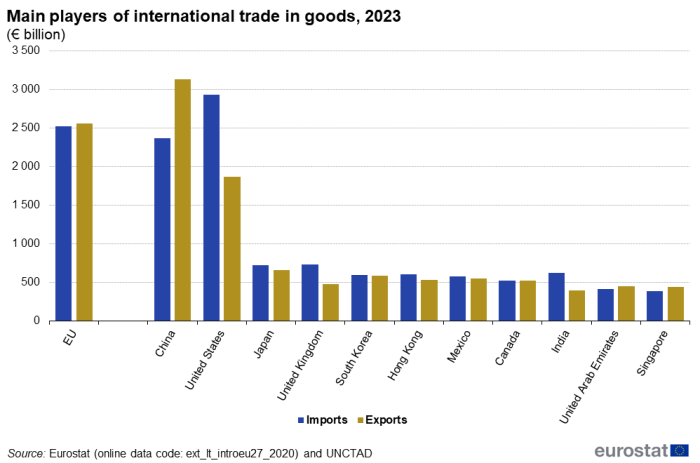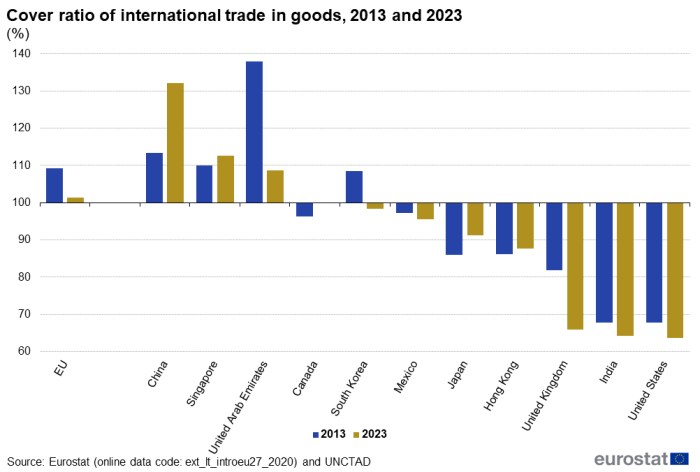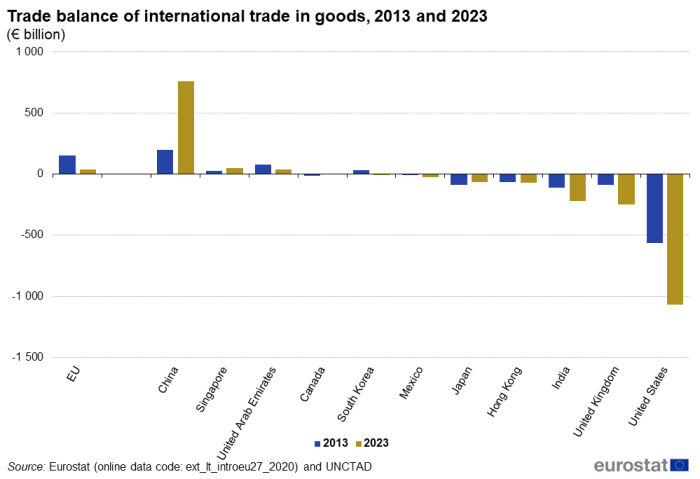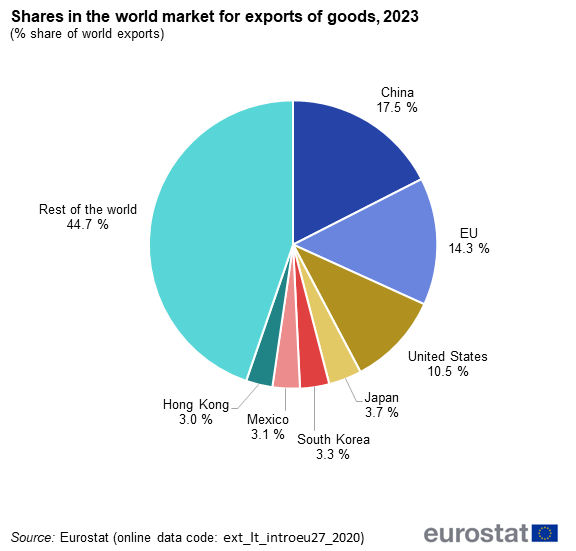Data extracted in August 2024 (part "The three largest global players for international trade: EU, China and the USA") and March 2025 (rest).
Planned article updates: August 2025 (part "The three largest global players for international trade: EU, China and the USA") and March 2026 (rest).
Highlights

This article discusses the development of the European Union's (EU) international trade in goods. It considers the EU's share in world import and export markets, intra-EU trade (trade between EU countries), the EU's main trading partners, and the EU's most widely traded product categories.
The EU accounts for around 14% of the world's trade in goods. The value of international trade in goods significantly exceeds that of services (by about three times), reflecting the nature of some services which makes them harder to trade across borders.
This article is part of an online publication providing recent statistics on international trade in goods, covering information on the EU's main partners, main products traded, specific characteristics of trade as well as background information.
EU imports decreased in 2023
In 2024, imports fell by 3.4% while exports increased by 1.1%. In 2020, EU trade was hit hard by the COVID-19 pandemic, with a significant fall observed for both exports (-9.4%) and imports (-11.6%) (see Figure 1). However, both recovered strongly in 2021 and 2022. In 2023 compared with 2022, exports remained stable but imports declined by 16.1%, mainly due to falling prices of energy.
In 2024, the EU trade in goods balance registered a surplus of €147 billion. This marks a great contrast to 2022 when the EU reported a deficit of €436 billion due to the high value of energy imports resulting from high energy prices.

Source: Eurostat (ext_lt_intratrd)
A more detailed view is given in Figure 2. In the last 3 months of 2024 compared with the same months in 2023, imports increased every month. By contrast, between February 2023 and March 2024, compared with the same month a year earlier, imports decreased every month. In 2024 exports grew in 7 of the months, most notably in April and July. In 2023 exports increased in the first 3 months and in June but decreased in all other months, most notably in September.

Source: Eurostat (ext_st_eu27_2020sitc)
Among the EU countries, Germany had by far the highest share of extra-EU trade in 2024, contributing 27.4% of the EU's exports of goods to non-EU member countries and accounting for almost one-fifth (18.6%) of the EU's imports (see Figure 3). The next three largest exporters, Italy (11.8%), France (10.6%) and the Netherlands (10.2%) were the only other EU countries with a double-digit share of EU exports. The Netherlands (17.8%), France (10.4%) and Italy (9.9%) followed Germany as the largest importers of goods from non-member countries in 2024. The relatively high share for the Netherlands can, at least in part, be explained by the considerable amount of goods that flow into the EU through Rotterdam, which is the EU's leading sea port, the so called Rotterdam effect.
The largest extra-EU trade surplus in goods, valued at €255.0 billion in 2024, was recorded by Germany, followed by Italy (€65.1 billion) and Ireland (€57.1 billion). The largest trade deficits for extra-EU trade in goods were recorded by the Netherlands (€170.2 billion), Spain (€45.6 billion) and Poland (€22.9 billion) as shown in Table B in the excel file attached below.
Trade in goods between EU countries (intra-EU trade) was valued — in terms of exports — at €4 025 billion in 2024. This was 56% higher than the level recorded for exports leaving the EU to non-EU member countries of €2 584 billion (extra-EU trade).
As with extra-EU trade, Germany was also the EU country with the highest level of intra-EU trade in 2023, contributing 21.0% of the EU's exports of goods to other EU countries and 22.0% of the EU's imports of goods from other EU countries (see Figure 4). The Netherlands (14.6%) was the only other EU country to contribute more than one tenth of intra-EU exports, again a consequence of the Rotterdam effect, while France (11.3%) was the only other EU country to account for more than one tenth of intra-EU imports.
The significance of the EU's internal market is underlined by the fact that intra-EU trade in goods (exports and imports combined) was higher than extra-EU trade (exports and imports combined) for all EU countries, except Ireland and Slovenia (see Figure 5). The proportion of total trade in goods that was accounted for by intra-EU and extra-EU flows varied considerably across countries, reflecting to some degree historical ties and geographical location. In 2024, the highest shares of intra-EU trade (above 75% of total trade) were recorded for Czechia (75.7%), Latvia (76.4%), Slovakia (78.8%), Estonia (78.9%) and Luxembourg (87.3%) with this ratio falling to 48.3% for Slovenia and 40.3% for Ireland.
This finding is confirmed in Figure 6, which shows most EU countries' exports as well as imports are with other EU countries. The exceptions were Ireland (for both imports and exports), Cyprus and Malta (only for exports) and Slovenia and the Netherlands (only for imports).
United States largest partner for exports, China for imports
The United States remained the largest destination for goods exported from the EU in 2024 (see Figure 7) with a share of 20.6%. The United Kingdom came second (13.2% of the EU total), followed by China (8.3%). China was the largest supplier of goods into the EU in 2024 with a share of 20.1%. The United States (12.9%) followed at some distance.
Between 2023 and 2024, among the main trading partners, the highest annual growth rate was recorded for exports to the United States (5.6%) and Japan (4.5%) while exports to China (-4.6%) and South Korea (-2.7%) dropped most (see Figure 7).
On the import side, between 2023 and 2024, imports of goods dropped most from Norway (-13.0%) and Japan (-10.7%). The largest increases for imports were recorded for India (+9.0%) and Brazil (+3.2%).

Source: Eurostat (ext_lt_maineu)
Large trade surplus for machinery and vehicles and chemicals
In 2024, the EU trade in goods balance registered a surplus of €147 billion (see Figure 8), representing a €113 billion increase compared with 2023 (€34 billion). Between 2014 and 2024, the EU recorded a trade surplus every year except for 2022, when high energy prices led to a significant deficit. In all other years, surpluses in machinery, vehicles, and chemicals outweighed the deficits caused by energy prices. The chemicals and related products group registered the largest increase in the last decade, doubling the surplus observed in 2014 from €119.1 billion to €238.1 billion. The balance of food and drink also increased significantly from €33.5 billion to €52.4 billion. In contrast, other manufactured goods switched from a surplus of €35.3 billion in 2014 to a deficit of €11.2 billion in 2024.
The shares by product of the EU's exports of goods did not change much between 2023 and 2024 (see Figure 9). There was a decrease of 1.2 percentage points (pp) for chemicals and related products and an increase for machinery & vehicles of 1.0 pp.
For the shares by product of the EU's imports, there was a increase for the share of energy (+2.5 pp) between 2023 and 2024 (see Figure 10). By contrast, over the same period the share of all other products group decreased, most notably for other manufactured goods (-0.9 pp).

(% share of extra-EU imports)
Source: Eurostat (ext_lt_intertrd)
Figure 11 compares the structure of the EU's imports with exports in 2024. It should be noted that the overall level of exports was 6.0% higher than the level of imports. The most notable difference is in the share of energy which was almost four times as high for imports as for exports. This was balanced by lower import shares for machinery and vehicles and chemicals compared with exports.
The 3 largest global players of international trade: EU, China and the USA
The EU, China and the United States have been the 3 largest global players within international trade (see Figure 12) since 2004 when China surpassed Japan. In 2023, the total level of trade in goods (exports and imports) recorded for the EU was €5 073 billion (note this does not include intra-EU trade), which was €417 billion lower than the value for China and €271 billion above the level recorded for the United States.

Source: Eurostat (ext_lt_introeu27_2020) and UNCTAD
In 2023, the ratio of exports to imports (the cover ratio) was particularly high in favour of exports of China (see Figure 13), which in absolute terms also had the largest annual trade surplus. The cover ratio was lowest for the United Kingdom, India and the United States.

Source: Eurostat (ext_lt_introeu27_2020) and UNCTAD
In 2023, the United States had the largest deficit (see Figure 14), continuing a pattern that has been apparent over the whole of the last decade for which data are available, while China had the largest surplus.

Source: Eurostat (ext_lt_introeu27_2020) and UNCTAD
Looking at the flows of exports, the EU (14.3%) had the second largest share of global exports of goods behind China (17.5%) but before the United States (10.5%), see Figure 15.

Source: Eurostat (ext_lt_introeu27_2020) and UNCTAD
Looking at the flows of imports, the EU (13.7%) also had the second largest share of global imports of goods behind the United States (15.9%) but before China (12.9%), see Figure 16.

Source: Eurostat (ext_lt_introeu27_2020) and UNCTAD
Source data for tables and graphs
Data sources
Statistics on the international trade of goods measure the value and quantity of goods traded between EU Member States (known as intra-EU trade) and goods traded by Member States with non-EU member countries (known as extra-EU trade). These statistics are the official source of information on imports, exports and the trade balance in the EU, its Member States and the euro area.
Statistics are published for each declaring country with respect to each partner country, for several product classifications. One of the most commonly used product classifications is the standard international trade classification (SITC Rev. 4) of the United Nations (UN); this allows a comparison of international trade statistics to be made on a worldwide basis.
In extra-EU trade statistics, the data shown for the EU treat this entity as a single trading block. In other words, the data for exports relate only to those exports from the EU that leave the trading block and are destined for the rest of the world, while extra-EU imports relate to imports from the rest of the world (non-EU member countries) coming into the EU. By contrast, when reporting data for individual EU Member States, international trade flows are generally presented in terms of world trade flows (including both intra-EU and extra-EU partners). Statistics on trade between the EU Member States (intra-EU trade) cover imports and exports of goods recorded by each Member State.
The statistical values of extra- and intra-EU trade are recorded at their free-on-board (FOB) value for exports and their cost, insurance and freight (CIF) value for imports. The values reported comprise only those subsidiary costs (freight and insurance) which relate, for exports, to the journey within the territory of the EU Member State from which the goods are exported and, for imports, to the journey outside the territory of the Member State into which the goods are imported.
EU data come from Eurostat's COMEXT database, the reference database for international trade in goods. It provides access not only to both recent and historical data from the EU Member States, but also to statistics for a significant number of non-EU member countries. Aggregated and detailed statistics for international trade in goods as disseminated through Eurostat's website are compiled from COMEXT each month. As COMEXT is updated on a daily basis, data published on the website may differ from the data found in COMEXT (in case of recent revisions).
Data for the non-EU major traders used in Figures 14 to 18 are taken from the UNCTAD database of the United Nations. For the calculation of shares the world trade is defined as the sum of EU trade with non-EU countries (source: Eurostat) plus the international trade of non-EU countries (source: UNCTAD).
Context
Statistics on the international trade of goods are used extensively by decision makers at an international, EU and national level. Businesses may use international trade data to carry out market research and define their commercial strategy. Statistics for international trade in goods are also used by EU institutions in their preparation of multilateral and bilateral trade negotiations, for defining and implementing anti-dumping policies, for the purposes of macroeconomic and monetary policies, and in evaluating the progress of the single market, or the integration of European economies.
The development of trade can be an opportunity for economic growth. The EU has a common trade policy, whereby the European Commission negotiates trade agreements and represents the EU's interests on behalf of its 27 Member States. The European Commission consults EU Member States through an advisory committee which discusses the full range of trade policy issues affecting the EU including multilateral, bilateral and unilateral instruments. As such, trade policy is an exclusive power of the EU — so only the EU, and not individual EU Member States, can legislate on trade matters and conclude international trade agreements. More recently, this scope has been extended beyond trade in goods, to cover trade in services, intellectual property and foreign direct investment (in chapter 4).
Globally, multilateral trade issues are dealt with under the auspices of the World Trade Organisation (WTO). The WTO has 166 members (as of August 2024), with several candidate members in the process of joining. The WTO sets the global rules for trade, provides a forum for trade negotiations, and for settling disputes between members. The European Commission negotiates with its WTO partners and participated in the latest round of WTO multilateral trade negotiations, known as the Doha Development Agenda (DDA).







